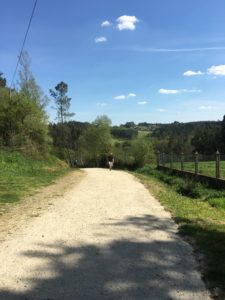The Camino de Santiago is a public event that passes through some of the most remote parts of Spain.
The miracle is that the pilgrimage is so little touched by crime, especially given the surge in participation over the past 20 years, crossing the 275,000 mark in 2016, with women making up almost half of the peregrinos — as pilgrims are known, in Spanish.
Over the past four days we have walked along paths hidden from much of the world, even on a heavily traveled portion of the trail, and given crime nary a thought.
And then this: Word this very day on the 23-year prison sentence given to a Spanish man for murdering a 41-year-old American pilgrim in 2015Â in a remote part of the popular Camino Frances.
The killing of Denise Thiem, from Arizona, sent a chill through what is mostly a joyful event in which the outside world sometimes seems remote.
She disappeared on April 5, 2015, apparently after becoming lost near the shack where the convicted murderer, Miguel Angel Munoz, 39 at the time of the crime, robbed Thiem of $1,100 and then killed her and buried her body near his shack on a rural road.
The Spanish investigation of the disappearance of Thiem, who at first was listed as a missing person, picked up momentum later in 2015 when U.S. Senator John McCain offered FBI support to Spanish authorities who, thereafter, seemed to devote more attention to the case.
Ultimately, they arrested Angel Munoz, who confessed to killing Thiem. He subsequently led authorities to the site where he buried her body.
Even in the part of the camino we traveled, which carries the greatest bulk of pilgrim traffic to Santiago, there are times on forest paths where a crime could be committed with few (if any) witnesses.
Thiem was in Leon state, between the cities of Astorga and El Ganso, when she apparently lost her way; directional markers are far less common in the less-populated areas of the camino.
Even here, near the end of the walk, where markers are common, it is easy to stray off the path. We have done it twice so far, once in a cluster of lonely buildings, and had to retrace our route.
On other parts of the way, missing a guidepost can mean hours of lost time trying to return to the trail.
In the murder case, the killer apparently reproduced one of the yellow arrows that show the route, sending the victim toward his shack, which was not on the track.
Evidence was offered in court by people who also had taken that wrong turn and reported problems with the convicted man.
One other violent death has been reported over the past two years, on the site called camino crime watch — involving a Belgian man, Jeroen Schelstraete, whose “body was found hidden under a pile of compost at the recycling center of San Roman de la Vega. According to local investigators, Jeroen was dumped after he was run over by a car. They also investigate a possibility of murder.” He reportedly had been robbed a few days before “and lost his money, papers and medication [and] may have been disoriented, when he apparently suffered fatal injuries …”
It seems unlikely those two deaths will reduce the number of pilgrims who desire to make the walk; in our brief experience, the notion of crime was something pilgrims do not consider — even in an unknown country and in some lonely places.
Tomorrow, we hope to be among perhaps 500 peregrinos who will complete their pilgrimage at the Santiago cathedral.
We may be battered by the long walks, and tired, but we will not have been assaulted, let alone killed, for attempting the route.
Some private prayers no doubt will be said for the unfortunate two peregrinos, and some of us will recommend greater caution by those who launch themselves into the camino.


0 responses so far ↓
There are no comments yet...Kick things off by filling out the form below.
Leave a Comment